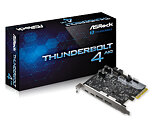- Joined
- Oct 9, 2007
- Messages
- 47,895 (7.38/day)
- Location
- Dublin, Ireland
| System Name | RBMK-1000 |
|---|---|
| Processor | AMD Ryzen 7 5700G |
| Motherboard | Gigabyte B550 AORUS Elite V2 |
| Cooling | DeepCool Gammax L240 V2 |
| Memory | 2x 16GB DDR4-3200 |
| Video Card(s) | Galax RTX 4070 Ti EX |
| Storage | Samsung 990 1TB |
| Display(s) | BenQ 1440p 60 Hz 27-inch |
| Case | Corsair Carbide 100R |
| Audio Device(s) | ASUS SupremeFX S1220A |
| Power Supply | Cooler Master MWE Gold 650W |
| Mouse | ASUS ROG Strix Impact |
| Keyboard | Gamdias Hermes E2 |
| Software | Windows 11 Pro |
ASRock today unveiled the Thunderbolt 4 AIC, an add-on card that puts out two 40 Gbps Thunderbolt 4 ports in the USB-C form-factor, with DisplayPort 1.4 passthrough. The card works exclusively with ASRock's Intel 500-series chipset motherboards that have a special header needed by the card called "TBT_Header" (similar to the "TB_Header" on certain ASUS motherboards). In addition, the card needs a 9-pin USB 2.0 connection to one of the vacant headers on the motherboard.
The compact, yet full-height add-on card features a PCI-Express 3.0 x4 host interface, and is based on Intel JHL8540 "Maple Ridge" controller. It has two full-size DisplayPort 1.4 inputs, a pair of included DP cables lets you connect the card to your graphics card. The controller supports up to 5 devices in Thunderbolt daisy-chains. The DisplayPort passthrough supports resolutions of up to 5K @ 60 Hz. The card measures 8.4 cm in length, 10.41 cm in height, and is 1 slot thick. The company didn't reveal pricing.



View at TechPowerUp Main Site
The compact, yet full-height add-on card features a PCI-Express 3.0 x4 host interface, and is based on Intel JHL8540 "Maple Ridge" controller. It has two full-size DisplayPort 1.4 inputs, a pair of included DP cables lets you connect the card to your graphics card. The controller supports up to 5 devices in Thunderbolt daisy-chains. The DisplayPort passthrough supports resolutions of up to 5K @ 60 Hz. The card measures 8.4 cm in length, 10.41 cm in height, and is 1 slot thick. The company didn't reveal pricing.



View at TechPowerUp Main Site






